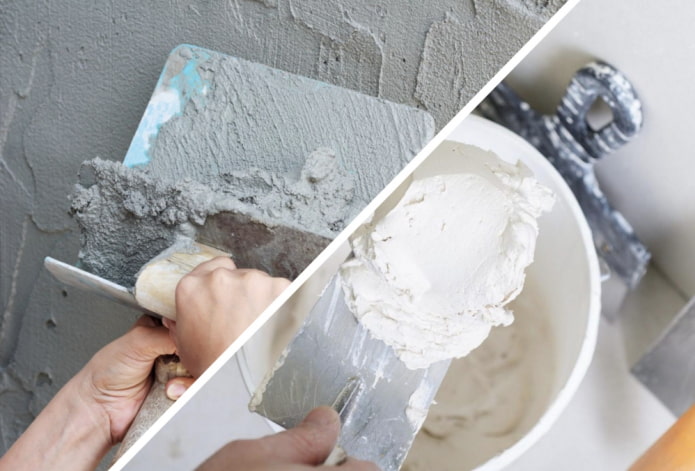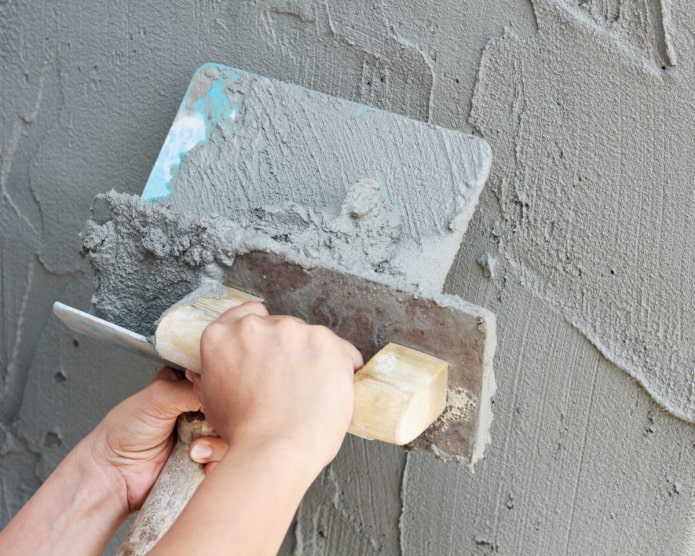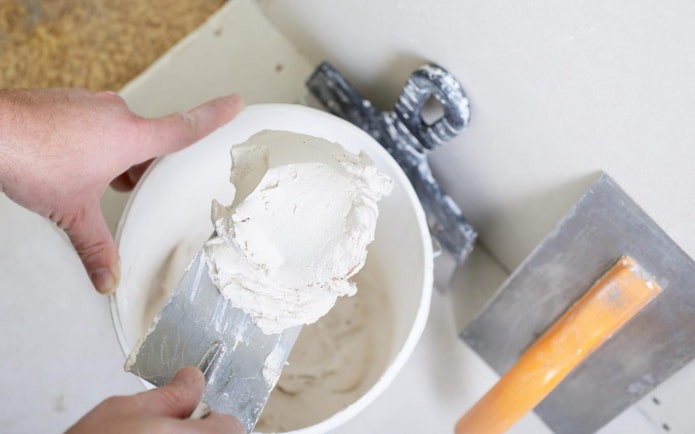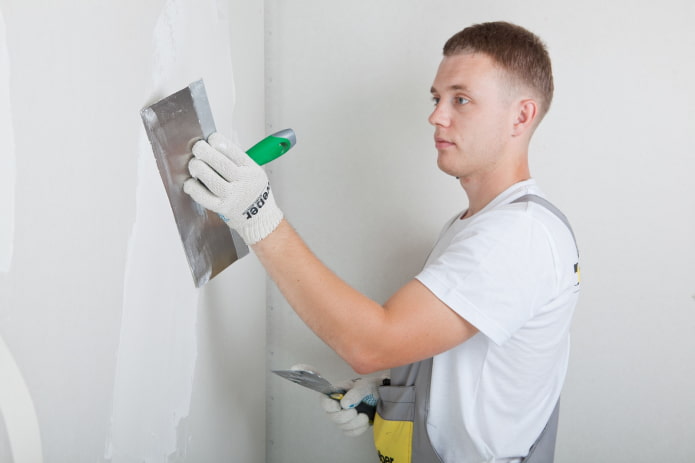Determining the terms
Let's start with the terminology.
Plaster (from the Italian stucco - gypsum, alabaster) - a mixture for leveling walls based on gypsum, or sand and cement with rather large particles.
It is used for rough work, neutralization of serious deviations of the plane vertically or horizontally, and the elimination of large notches. Depending on the composition, it improves sound, heat and waterproofing of walls.
Putty or putty (from the German spachtel - scapula) - a pasty finely dispersed composition with which you can get rid of small defects on the surface. It is used as a barrier between the preparatory finish (plaster) and the topcoat (paint, wallpaper). Gypsum, cement, polymers and even oil are used as the basis for the mixture - we will talk about their differences in the next section.
Difference of compositions
Plaster
Depending on the scope of application, plaster is:
- Gypsum... It is made from gypsum powder and binders. A plastic mass with excellent adhesion to various materials. Due to its low weight, it can be used not only on brick or aerated concrete, but also on fragile movable bases - for example, gypsum board. Gypsum is ideal for living quarters - it is 100% environmentally friendly, hygroscopic (it picks up excess moisture and gradually returns it to the air). But cannot be used outdoors or in unheated humid spaces.
- Cement... The available mixture of sand and cement primarily stands out for its reliability and durability. Subject to all the recommendations for application, it serves for 10+ years: and it can be used both inside and outside buildings, because does not respond to changes in temperature or humidity. Cement is not as plastic as gypsum, but it can be applied with a thick (4-7 cm) layer, due to which the leveling of serious vertical, horizontal "blockages" is allowed.
It is rare to find cement-lime plasters: lime adds plasticity to the cement, but makes it less resistant to moisture.
Putty
There are more composition options, but gypsum or cement-based mixtures are also considered the most popular.
- Cement... It is prepared according to the principle of plaster, only the grain size of cement and sand is taken to be minimal. The composition is inexpensive, has increased strength, but it is quite difficult to apply this. Therefore, modern builders are rarely used. However, in some cases (for example, in rooms with high humidity), cement putty is simply irreplaceable.
- Gypsum... It is not much more expensive than cement, but it is easily applied - even a beginner can handle it. If the mixture is used for its intended purpose (in dry heated spaces), it lasts a long time, does not crack, does not exfoliate. Another plus is environmental friendliness. Natural gypsum with plasticizers is absolutely safe for health.
- Polymer... The search for more versatile, reliable and easy-to-use formulations has led to polymer-based blends. Depending on the base, acrylic, latex, polymer-cement putty is distinguished. Universal acrylic is not afraid of water, fits on any bases (brick, concrete, drywall, wood, metal), lasts a long time, does not crack. The layer can be 1 mm or more: the fine fraction allows you to achieve a perfectly smooth surface. Latex is more flexible, ideal for drywall and other coatings that can lead. To avoid cracks, a layer> 3 mm must not be applied. The latter is improved cement. Polymers made the usual gray putty more plastic and easier to work with.
- Oil... Due to the composition (drying oil, driers, acrylates) it smells quite specifically, and in terms of properties it is inferior to most modern analogues, therefore, its use is not justified today.
Putties are sold both in dry mixes and ready-made pastes - ready-made ones are more expensive, but you can use them immediately after purchase. Dry ones will have to be diluted with water on their own to the required state.
Differences in application
The main thing to remember: in a puff cake of a wall or ceiling, first put plaster, then putty. That is, the stage of plastering - roughing, filling - a buffer between roughing and finishing.
Plaster is used for leveling, insulation, soundproofing of various surfaces inside and outside the premises. Usually, plaster is used on the lighthouses - thanks to the installation of special guides, you can create perfectly smooth walls with correct angles at 90 degrees.
You can apply a layer up to 4 cm at a time without mesh, up to 7 cm using a reinforcing base.
The putty smooths out small irregularities - for example, the rough texture of the plaster, the seams between the plasterboard or small cracks. Usually it is applied with a layer of 1-10 mm, but it can reach 2 cm - depending on the composition.
There are two main types of putties: starting and finishing. The first is applied in a relatively thick layer, has a fine texture. The second is an almost smooth paste for final leveling. It is applied with a layer of 1 mm.
Difference in application methods
There are 2 main methods of applying plaster - manual and machine.
- In the first case, the master independently throws the material onto the surface, then distributes the composition evenly over the base with a spatula, rule or trowel.
- In the second, a special pump is used, thanks to which the mixture is distributed over the wall or other covering, after which it is neatly leveled.
The putty is also sometimes applied automatically, but more often it is worked manually using two spatulas (narrow and wide) or a roller (they usually make the finishing layer).
Pivot table
Let's summarize and compare the materials:
| Plaster | Putty |
|---|---|
| Medium or large fraction | Fine or ultrafine dispersion |
| Used for rough work | For finishing preparation of walls for finishing work |
| Sold in powder | You can find powder or ready-made paste in stores. |
| Sometimes gypsum or cement | Sometimes gypsum, cement, acrylic, oil |
| Apply in a thick layer up to 7 cm | One layer rarely exceeds 1 cm |
| Removes large defects, evens out vertical, horizontal drops | Eliminates minor imperfections, makes the coating smooth |
Plaster and putty are two completely different compositions with different properties. It is not worth replacing one mixture with another - each must fulfill its own task.


 10 practical tips for arranging a small kitchen in the country
10 practical tips for arranging a small kitchen in the country
 12 simple ideas for a small garden that will make it visually spacious
12 simple ideas for a small garden that will make it visually spacious






 What is better not to do it yourself during the repair?
What is better not to do it yourself during the repair? Bloated linoleum: how to fix it without disassembly
Bloated linoleum: how to fix it without disassembly The worst decisions in apartment renovation
The worst decisions in apartment renovation  Installation of ceiling tiles: choice of materials, preparation, order of work
Installation of ceiling tiles: choice of materials, preparation, order of work How to glue a ceiling plinth to a stretch ceiling?
How to glue a ceiling plinth to a stretch ceiling? Ceiling plinth for stretch ceiling: types, recommendations for selection
Ceiling plinth for stretch ceiling: types, recommendations for selection